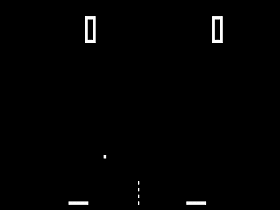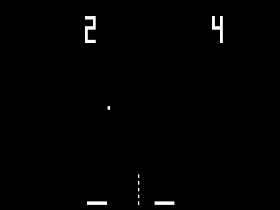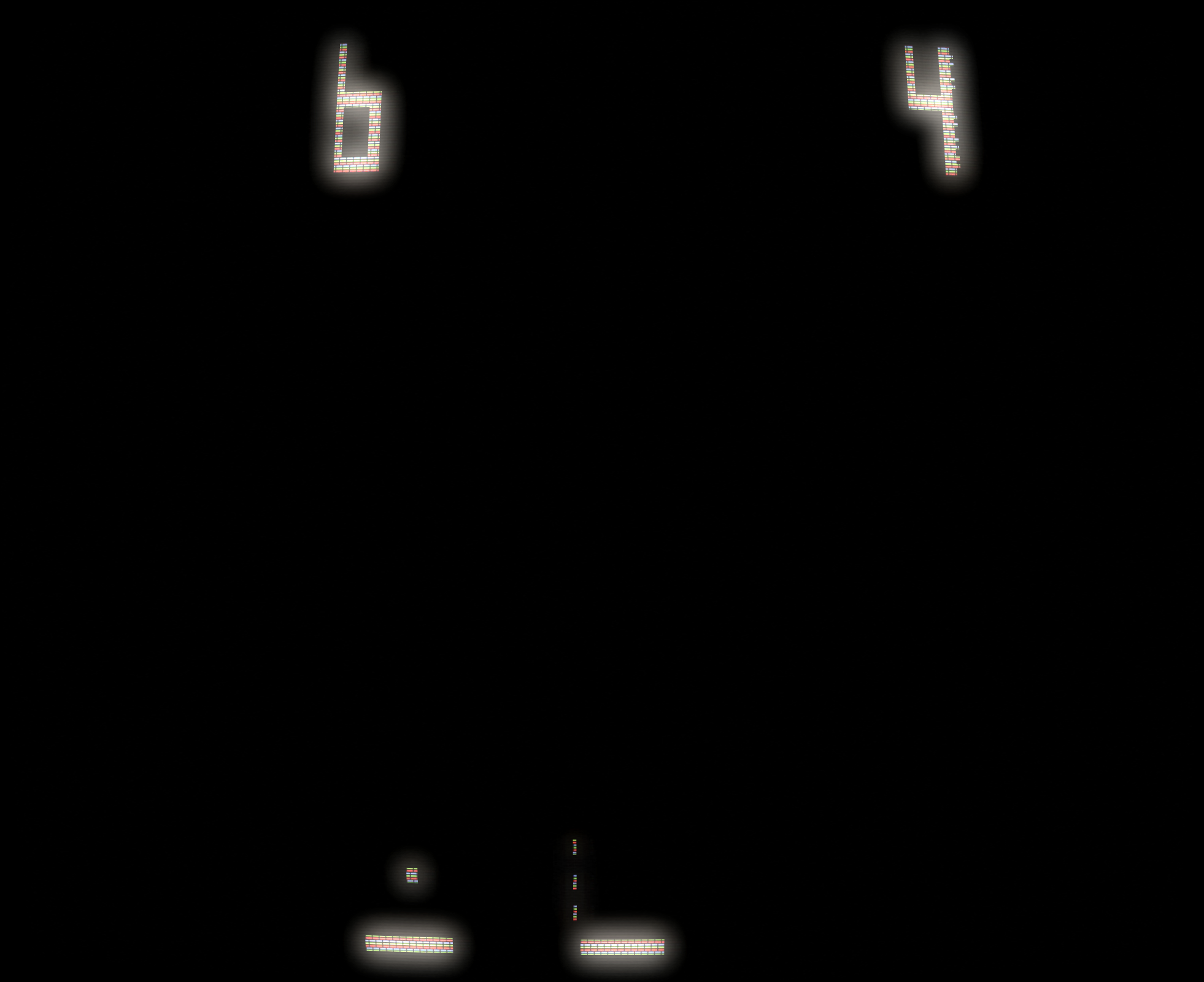 The Game: Live in glorious black & white, it’s the first-ever game of video volleyball! Two players square off – well, okay, rectangle off – against each other as horizontal Pong paddles situated on either side of a dotted-line “net.” The ball drops out of mid-air toward one player or the other, who must move into place to (hopefully) bounce the ball into the right direction. It may take a couple of tries to get the ball over the net, but don’t let it take three bounces or you forfeit a turn (and a point). (Atari, 1973)
The Game: Live in glorious black & white, it’s the first-ever game of video volleyball! Two players square off – well, okay, rectangle off – against each other as horizontal Pong paddles situated on either side of a dotted-line “net.” The ball drops out of mid-air toward one player or the other, who must move into place to (hopefully) bounce the ball into the right direction. It may take a couple of tries to get the ball over the net, but don’t let it take three bounces or you forfeit a turn (and a point). (Atari, 1973)
Memories: Created on a hardware with a very similar architecture to that of Pong, Rebound was Atari’s first attempt to think outside the Pong box. Obviously, there are similarities: Pong paddles stand in for volleyball players, and the ball and “net” graphics are familiar enough to anyone who’s ever laid eyes on Pong. But where Pong only needed to simulate artificial action and reaction, Rebound actually has a tougher job: simulating real live gravity. But Rebound‘s gravity is a bit unpredictable and not quite authentic. Sure, volleyballs have been known to go astray, but Sir Isaac Newton would be left reeling by Rebound‘s first-ever video game simulation of real physical laws.
Put simply, Rebound is a gravitational crap shoot. You have as good a chance of knocking the ball further back into your own territory as you do of getting it across the net – perhaps even better. Ironically, this problem with Rebound was recognized and resolved, but not by Atari…at least not officially. Rebound was sold at the time that Atari was attempting to upstage its own competition by releasing its own clone games as Kee Games, partly to circumvent a distribution system that favored some manufacturers over  others, but also partly to steal the thunder of numerous companies – some of them fly-by-night, others quite reputable future players in the video game industry – who had relentlessly cloned Pong for their own gain. By controlling both the Atari originals and the Kee Games “knockoffs,” Atari founder Nolan Bushnell was playing both sides against the middle.
others, but also partly to steal the thunder of numerous companies – some of them fly-by-night, others quite reputable future players in the video game industry – who had relentlessly cloned Pong for their own gain. By controlling both the Atari originals and the Kee Games “knockoffs,” Atari founder Nolan Bushnell was playing both sides against the middle.
But with Kee’s version of Rebound, called Spike, Bushnell’s game was almost too clever for Atari’s own good. Spike added a “spike” button which would make a player’s paddle “jump,” effectively spiking the ball over the net in volleyball terms. Spike improved on its “inspiration,” giving Kee Games a leg up. And to add insult to injury, Kee’s next major coin-op would be an original that threatened to upstage Atari’s output entirely, forcing Bushnell to call his own bluff and bring Kee back under Atari’s umbrella…where it had, in fact, been all along.
 Considering that the entire coin-op landscape at the time consisted of pinball, Computer Space and Pong (and several unauthorized clones thereof), Rebound was a bold move to get off the video ping-pong table and into a new kind of game, and it may even be considered among the very first (albeit only mildly successful) attempt to model real-world physics in a video game (Pong and Odyssey’s dreamily floating tennis balls and Computer Space‘s not-quite-accurate depiction of zero gravity may or may not count here)…but on its own merits it was no threat to Pong‘s dominance. Which may be just as well, because the other companies who were relentlessly issuing Pong knockoffs started doing the same with Rebound too.
Considering that the entire coin-op landscape at the time consisted of pinball, Computer Space and Pong (and several unauthorized clones thereof), Rebound was a bold move to get off the video ping-pong table and into a new kind of game, and it may even be considered among the very first (albeit only mildly successful) attempt to model real-world physics in a video game (Pong and Odyssey’s dreamily floating tennis balls and Computer Space‘s not-quite-accurate depiction of zero gravity may or may not count here)…but on its own merits it was no threat to Pong‘s dominance. Which may be just as well, because the other companies who were relentlessly issuing Pong knockoffs started doing the same with Rebound too.

